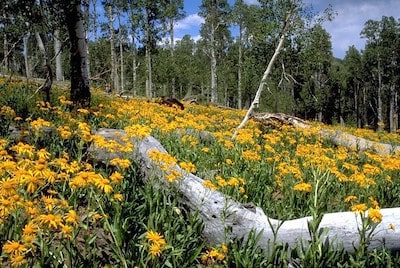
Do you have trouble keeping your yard alive during the hot summer months in Colorado Springs? Do you get tired of watering, or spending the large amount of money you need to keep your yard alive? Does your yard show it?
No problem. The Colorado State University does research and provides answers to local folks who wants to have a beautiful yard without the hassle in their fact sheet:
Colorado Mountain Gardening Basics, by by I. Shonle and L. Potts.
We've included this fact sheet below. Read it here, or
download the PDF for later reading by clicking here.
Quick Facts...
- Low humidity, fluctuating temperatures, a short growing season, poor soil characteristics, watering restrictions (in some cases), wildlife, wildfire, and drying winds make gardening in the mountains a challenge.
- Selecting plants that tolerate these conditions is key to Colorado mountain gardening basics.
- Gardeners who are patient, know how to select plants that will do well and manipulate the soil and microclimate, will be amply rewarded.
Gardeners new to mountain communities of Colorado often have trouble getting plants to thrive or even survive. There is no doubt that gardening in the mountains can be challenging, particularly above 7,500’. Sunlight is usually of high intensity and the humidity generally is low. Combinations of cool nights, a short growing season, drying winds, steepness of slopes, aspect, topography, and soil all influence how well plants perform in this climate. Wildlife can also be an issue. Most of these challenges can be overcome with proper site preparation and plant choices.
Site Choice
[caption id="attachment_2749" align="alignleft" width="400"]

Look for a place where plants are already flourishing. (Click to see larger, beautiful picture)[/caption]
To determine where to plant your garden, first evaluate your site. The best place to grow flowers is in a site that already supports some grass, wildflowers, or even weeds. This will usually be in a fairly sunny, open area. If the area has weeds, control them before planting something new. Aspen groves are an ideal environment for many plants, but other open areas also work well.
If dense evergreen trees cover your desired garden area and there is little vegetation growing underneath, most plants are unlikely to thrive. It may be necessary to remove the conifers and add organic matter to make these areas plantable. Likewise, if the soil is very rocky and there is no existing vegetation, increasing the organic content of the soil is critical.
Soils
[caption id="attachment_2751" align="alignright" width="400"]

add organic matter to soil[/caption]
There are two major types of soil found in the mountains. Light-colored decomposed granite soils, are low in organic matter, dry out quickly, and do not absorb heat well. They are usually high in most nutrients except for nitrogen. Clay soils are also high in nutrients, but generally have poor drainage.
Soil preparation is often the key to growing healthy plants in the mountains, particularly for non-native plants. Native plants are often adapted to leaner soils (lower in organic matter), and may ‘flop’ or have a shorter life span in well-amended soils.
In general, it is beneficial to add organic matter to any type of mountain soil, although in poorly drained soils it is best to add some each year, rather than all at once, in order to avoid salt buildup. Incorporate 2 to 3 inches of organic matter (or 3 cubic yards per 1,000 square feet of garden), such as alfalfa pellets, compost, or aged manure, to a depth of 6 to 12 inches. Avoid using Colorado mountain peat, as it is a non-renewable resource, has too fine of a texture, and is alkaline. It is best to work organic matter into the entire area that will be planted. If this is not feasible, dig a larger than necessary hole, and amend the backfill with 20 percent soil amendment. This also helps to prevent a ‘soil texture interface’ when planting nursery-grown container plants. The soil around the roots in a container is often high in organic matter, while the native soil can be lower in organic matter and may be a different texture. This soil texture interface may cause a zone beyond which the roots will not grow. Test the soil after adding organic material for nutrient deficiencies. Contact your Colorado State University Extension county office for soil test information. For more information on amending soils, see fact sheet
7.235, Choosing a Soil Amendment.
Raised Beds
Raised beds can solve many problems for mountain gardeners. Raised beds can be created with good, weed free soil, and are especially beneficial if soils are poorly drained or are very rocky and hard to dig. They also warm faster in the springtime and can help to protect the plants from burrowing rodents if a ¼” wire mesh (hardware cloth) is tacked onto the bottom before the soil is added.
Microclimates
The successful mountain gardener learns to exploit or create microclimates. For example, gardens placed in full sun (southern exposures) will have a longer, warmer growing season than other exposures. These warm or hot microclimates are the places to experiment with plants that need more heat during the growing season to come into flower before frost. If the site is protected in the winter, this is also a place to experiment with less hardy plants. Another good site for more tender plants is in front of rock formations or walls (natural or created) where the thermal mass can raise winter temperatures.
Because plant growth is slowed by cool mountain soil temperatures, creating a perennial bed that slopes towards the south or using raised beds will cause plants to grow faster and emerge earlier in the spring due to the increased soil temperature. These plants may be vulnerable to late spring frosts. Gardens on south-facing slopes are warmer and drier than gardens on north-facing slopes of the same valley at the same elevation.
Some mountain areas have a reliable blanket of snow over much of the winter. This acts as insulation and may allow less hardy plants (zone 5 or 6) to overwinter. Snow blankets can be encouraged in specific locations by putting up a snow fence; this will cause snow build up on the lee (downwind) side of the fence. This same snow blanket, however, may cause some xeric plants to rot out during the winter, even if they are cold hardy.
Also consider the flow of air; at night, cool air drains down to low spots. Valley floors may be over 10 degrees F cooler than surrounding gardens on hillsides above the valley floor.
Strong winds can cause plants to dry out. Dissociation can be reduced by using fences, trees, or shrubs to create a wind barrier.
Plant Choice
Even though many mountain gardeners live in wooded areas, ‘woodland plants’ are seldom good choices – this term in catalogues usually refers to Eastern woodland conditions (moist, organic rich, acid soils, and humid air). We have few to none of those conditions in our mountain areas.
Plants with smaller leaves will often require less water, and will also experience less damage from hail.
Be cautious with late-blooming plants or plants that are heat-lovers, as they probably won’t bloom before frost. This is because plants need to accumulate enough growing-degree days in order to mature. Late-blooming plants and heat lovers require more growing-degree days to develop.
In general, choose plants that are hardy to zones 2 to 4. Low temperatures are not the only factor in whether a plant will overwinter, however. Other factors include day length, source of plant material, recent temperature patterns, rapid temperature changes, soil moisture, wind exposure, sun exposure, and carbohydrate reserves.
Native plants are some of the best plants for the mountains because they are already adapted to the harsh conditions.
For further information on plant choices, see fact sheets:
- 7.406, Flowers for Mountain Communities,
- 7.423, Trees and Shrubs for Mountain Communities,
- 7.413, Groundcovers and Rock Garden Plants for Mountain Communities,
- 7.421, Native Trees for Colorado Landscapes,
- 7.422, Native Shrubs for Colorado Landscapes,
- 7.242, Native Herbaceous Perennials for Colorado Landscapes, and
- 7.233, Wildflowers for Colorado.
Local nurseries and garden centers (rather than nationwide chain stores) are also good resources, as they have more knowledge of local growing conditions. |
Planting
In mountain areas, the best time to plant flowers is either immediately after the last frost or during the rainy season. Planting in late summer or fall decreases the chance of survival, especially for borderline-hardy plants, and is less preferable. Gradually harden off (acclimate) nursery or greenhouse grown containerized plants, especially if they were purchased at lower elevations, or choose plants that have been grown outside at local nurseries. About two weeks before the anticipated planting time, reduce the amount of water the plants receive and expose the plants to increasingly longer periods of outdoor conditions. Start by placing the plants in a protected location, and gradually increase the exposure to sun and wind. Be prepared to provide temporary cover (frost caps, floating row covers, or even bed sheets) if the temperatures threaten to dip below freezing at night
Watering
Determine the source of water for the garden and the associated water rights. If it is a well with a household-only use permit (where no outside watering is permitted; this applies to most wells drilled after 1972 on less than 35 acres, see fact sheet
6.700, Private Wells for Home Use), water inputs can be minimized or eliminated by ‘planting with the precipitation.’ Plant drought-tolerant plants when the rainy season begins in your area which is often in early to mid-July. Plants should be watered on the day they are planted and then mulched to retain moisture. Trial gardens indicate a very high survival rate when planted this way. Wildflowers and native grasses sown in the fall also have little to no watering needs, see fact sheet
7.233, Wildflowers for Colorado.
Mulches
Use organic mulches such as weed-free straw, bark chips, or shredded bark to protect plants from severe drying where snow cover does not persist during the winter, and to increase soil moisture and decrease weeds in the summer. Organic mulches can delay spring growth; remove them in early spring to allow the soil to warm up. Netting or branches can help keep the wind from blowing the mulch off. Pea gravel or rock mulches are more wind-resistant, provide frost protection, increase the soil temperature for enhanced growth, particularly if it is dark-colored, and may allow self-seeding of plants. Floating row covers (spun-polyester fabric that allows light and moisture through) may also be used to protect perennials and newly seeded beds over the winter.
Wildlife in the Garden
Exclusion of animals such as deer, rabbits, voles, and ground squirrels from the garden is the most effective long-term solution. Each animal requires a somewhat different technique. If this is not possible, plant resistant plant species. While nothing is foolproof, in general, most wildlife will avoid plants that are very aromatic; have prickles or spines, tough, leathery leaves, milky sap; or are toxic. See fact sheet no.
6.520, Preventing Deer Damage for some plant suggestions.
Fire Mitigation
Many mountain homes are surrounded by wildfire-susceptible forests, so fire resistance should be considered when landscaping. In general, flammable plant materials such as conifers should be removed within 15 feet of the home, and nothing should be planted within 3 to 5 feet of the house, particularly if it is sided with a flammable material.
For more information, see the fact sheets
6.303, Fire Resistant Landscaping, and
6.305, Firewise Plant Materials, and Colorado State Forest Service quick guide
Protecting Your Home from Wildfire: Creating Wildfire-Defensible Zones.
*I. Shonle, Colorado State University Extension agent, Gilpin County; and L. Potts, former Extension agent, Eagle County. 4/08. Revised 12/14.
Colorado State University, U.S. Department of Agriculture and Colorado counties cooperating. CSU Extension programs are available to all without discrimination. No endorsement of products mentioned is intended nor is criticism implied of products not mentioned.
Updated Monday, March 09, 2015
 Do you have trouble keeping your yard alive during the hot summer months in Colorado Springs? Do you get tired of watering, or spending the large amount of money you need to keep your yard alive? Does your yard show it?
No problem. The Colorado State University does research and provides answers to local folks who wants to have a beautiful yard without the hassle in their fact sheet: Colorado Mountain Gardening Basics, by by I. Shonle and L. Potts.
We've included this fact sheet below. Read it here, or download the PDF for later reading by clicking here.
Do you have trouble keeping your yard alive during the hot summer months in Colorado Springs? Do you get tired of watering, or spending the large amount of money you need to keep your yard alive? Does your yard show it?
No problem. The Colorado State University does research and provides answers to local folks who wants to have a beautiful yard without the hassle in their fact sheet: Colorado Mountain Gardening Basics, by by I. Shonle and L. Potts.
We've included this fact sheet below. Read it here, or download the PDF for later reading by clicking here.
 Look for a place where plants are already flourishing. (Click to see larger, beautiful picture)[/caption]
To determine where to plant your garden, first evaluate your site. The best place to grow flowers is in a site that already supports some grass, wildflowers, or even weeds. This will usually be in a fairly sunny, open area. If the area has weeds, control them before planting something new. Aspen groves are an ideal environment for many plants, but other open areas also work well.
If dense evergreen trees cover your desired garden area and there is little vegetation growing underneath, most plants are unlikely to thrive. It may be necessary to remove the conifers and add organic matter to make these areas plantable. Likewise, if the soil is very rocky and there is no existing vegetation, increasing the organic content of the soil is critical.
Look for a place where plants are already flourishing. (Click to see larger, beautiful picture)[/caption]
To determine where to plant your garden, first evaluate your site. The best place to grow flowers is in a site that already supports some grass, wildflowers, or even weeds. This will usually be in a fairly sunny, open area. If the area has weeds, control them before planting something new. Aspen groves are an ideal environment for many plants, but other open areas also work well.
If dense evergreen trees cover your desired garden area and there is little vegetation growing underneath, most plants are unlikely to thrive. It may be necessary to remove the conifers and add organic matter to make these areas plantable. Likewise, if the soil is very rocky and there is no existing vegetation, increasing the organic content of the soil is critical.
 add organic matter to soil[/caption]
There are two major types of soil found in the mountains. Light-colored decomposed granite soils, are low in organic matter, dry out quickly, and do not absorb heat well. They are usually high in most nutrients except for nitrogen. Clay soils are also high in nutrients, but generally have poor drainage.
Soil preparation is often the key to growing healthy plants in the mountains, particularly for non-native plants. Native plants are often adapted to leaner soils (lower in organic matter), and may ‘flop’ or have a shorter life span in well-amended soils.
In general, it is beneficial to add organic matter to any type of mountain soil, although in poorly drained soils it is best to add some each year, rather than all at once, in order to avoid salt buildup. Incorporate 2 to 3 inches of organic matter (or 3 cubic yards per 1,000 square feet of garden), such as alfalfa pellets, compost, or aged manure, to a depth of 6 to 12 inches. Avoid using Colorado mountain peat, as it is a non-renewable resource, has too fine of a texture, and is alkaline. It is best to work organic matter into the entire area that will be planted. If this is not feasible, dig a larger than necessary hole, and amend the backfill with 20 percent soil amendment. This also helps to prevent a ‘soil texture interface’ when planting nursery-grown container plants. The soil around the roots in a container is often high in organic matter, while the native soil can be lower in organic matter and may be a different texture. This soil texture interface may cause a zone beyond which the roots will not grow. Test the soil after adding organic material for nutrient deficiencies. Contact your Colorado State University Extension county office for soil test information. For more information on amending soils, see fact sheet 7.235, Choosing a Soil Amendment.
add organic matter to soil[/caption]
There are two major types of soil found in the mountains. Light-colored decomposed granite soils, are low in organic matter, dry out quickly, and do not absorb heat well. They are usually high in most nutrients except for nitrogen. Clay soils are also high in nutrients, but generally have poor drainage.
Soil preparation is often the key to growing healthy plants in the mountains, particularly for non-native plants. Native plants are often adapted to leaner soils (lower in organic matter), and may ‘flop’ or have a shorter life span in well-amended soils.
In general, it is beneficial to add organic matter to any type of mountain soil, although in poorly drained soils it is best to add some each year, rather than all at once, in order to avoid salt buildup. Incorporate 2 to 3 inches of organic matter (or 3 cubic yards per 1,000 square feet of garden), such as alfalfa pellets, compost, or aged manure, to a depth of 6 to 12 inches. Avoid using Colorado mountain peat, as it is a non-renewable resource, has too fine of a texture, and is alkaline. It is best to work organic matter into the entire area that will be planted. If this is not feasible, dig a larger than necessary hole, and amend the backfill with 20 percent soil amendment. This also helps to prevent a ‘soil texture interface’ when planting nursery-grown container plants. The soil around the roots in a container is often high in organic matter, while the native soil can be lower in organic matter and may be a different texture. This soil texture interface may cause a zone beyond which the roots will not grow. Test the soil after adding organic material for nutrient deficiencies. Contact your Colorado State University Extension county office for soil test information. For more information on amending soils, see fact sheet 7.235, Choosing a Soil Amendment.














